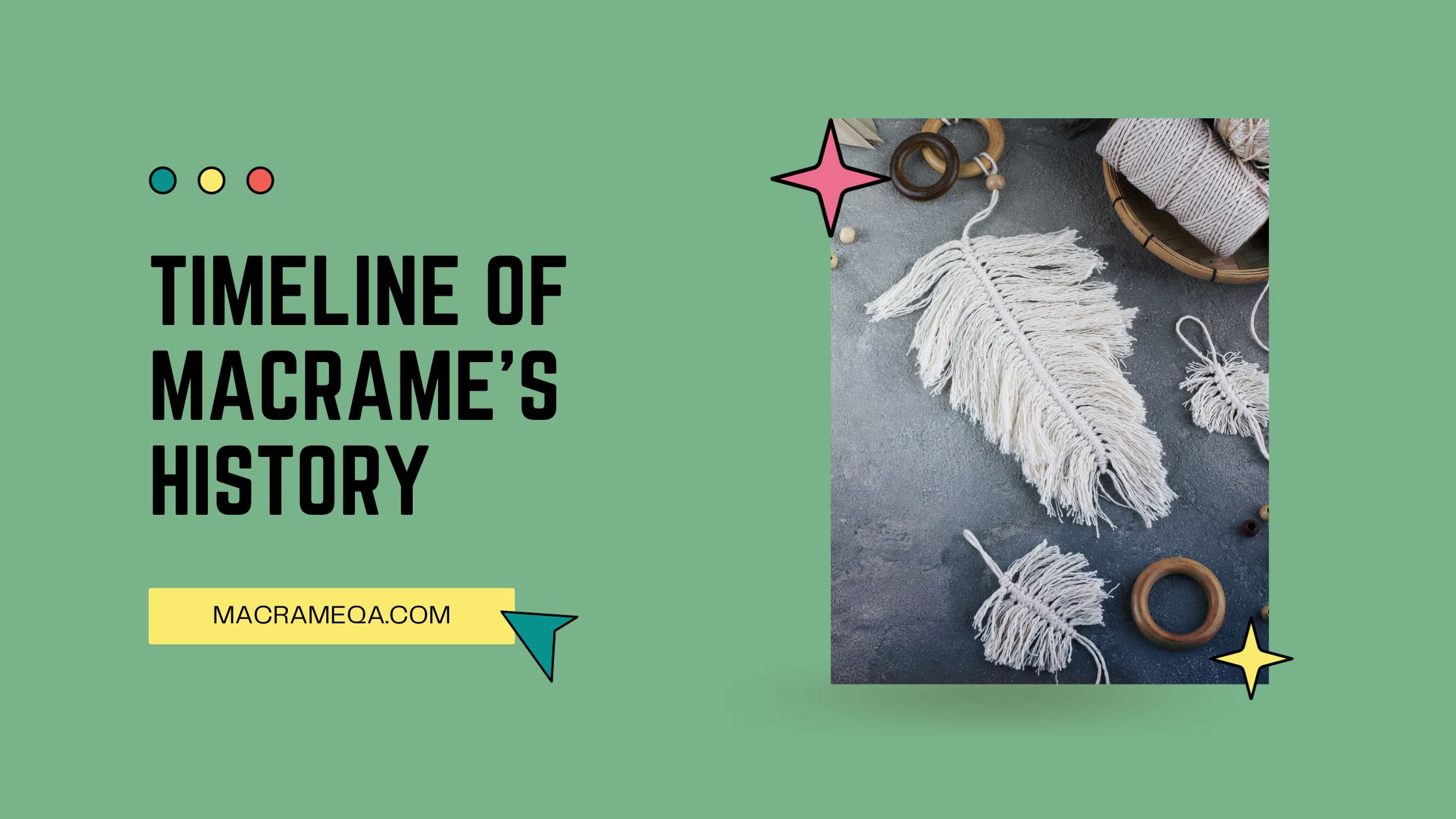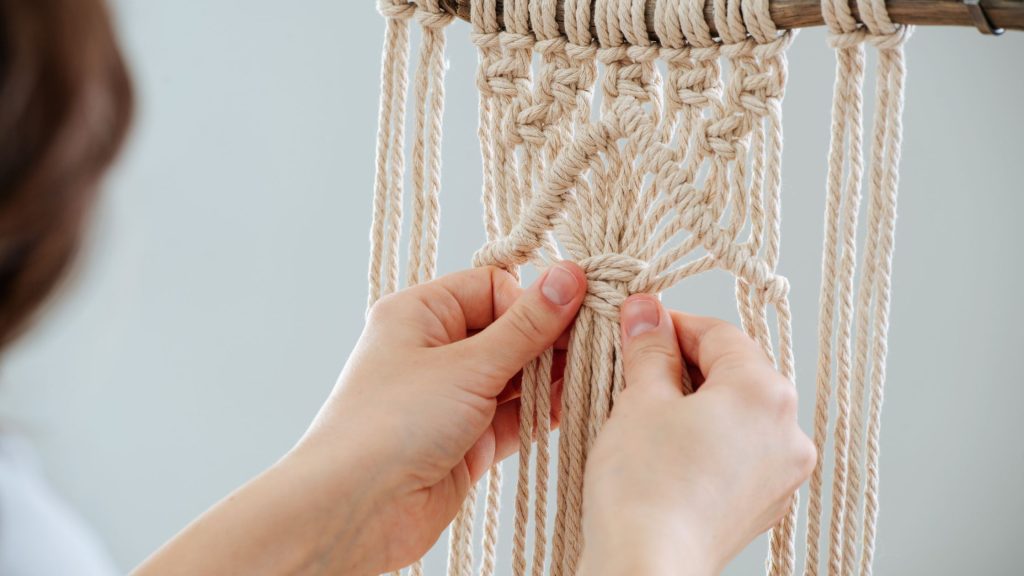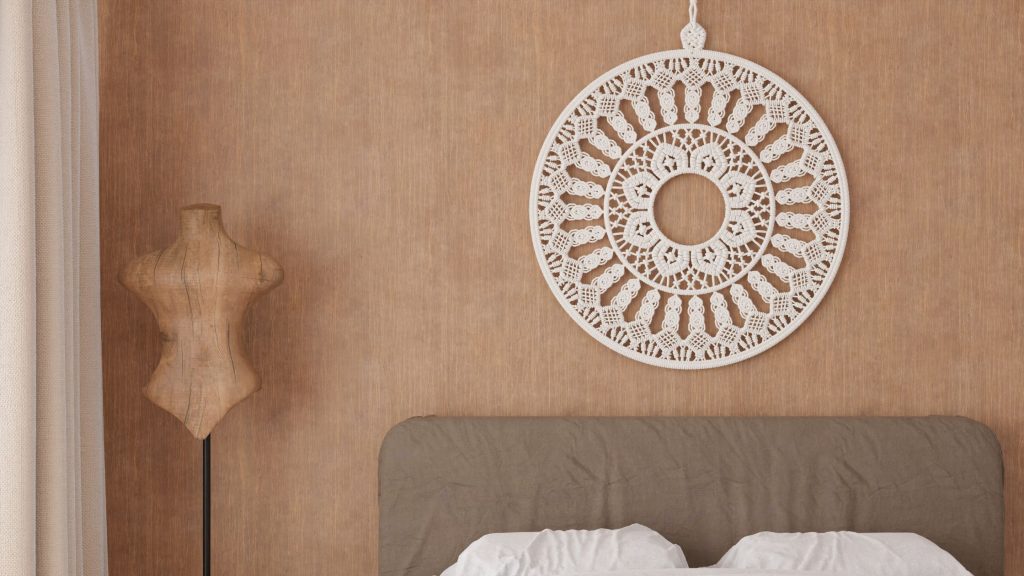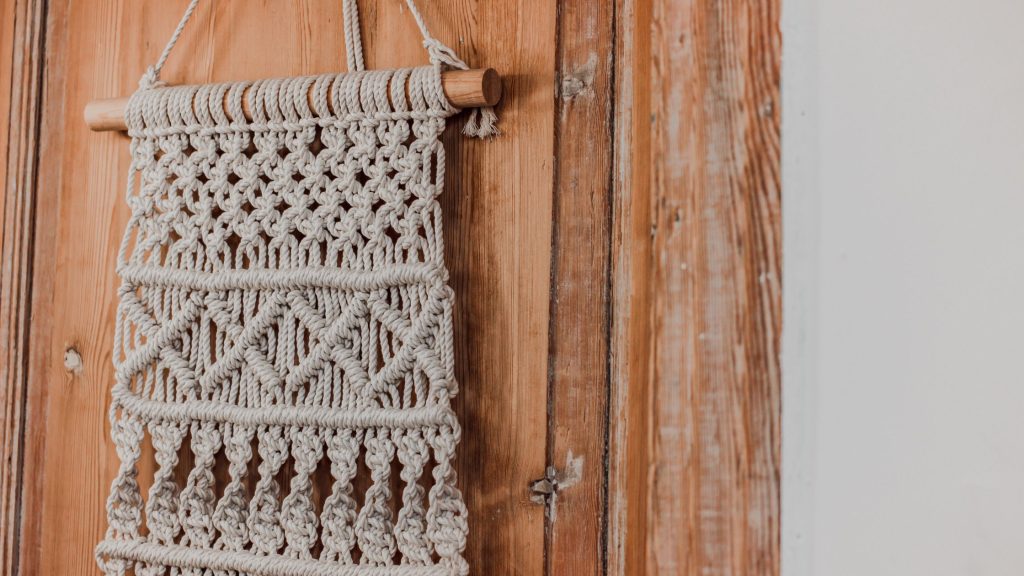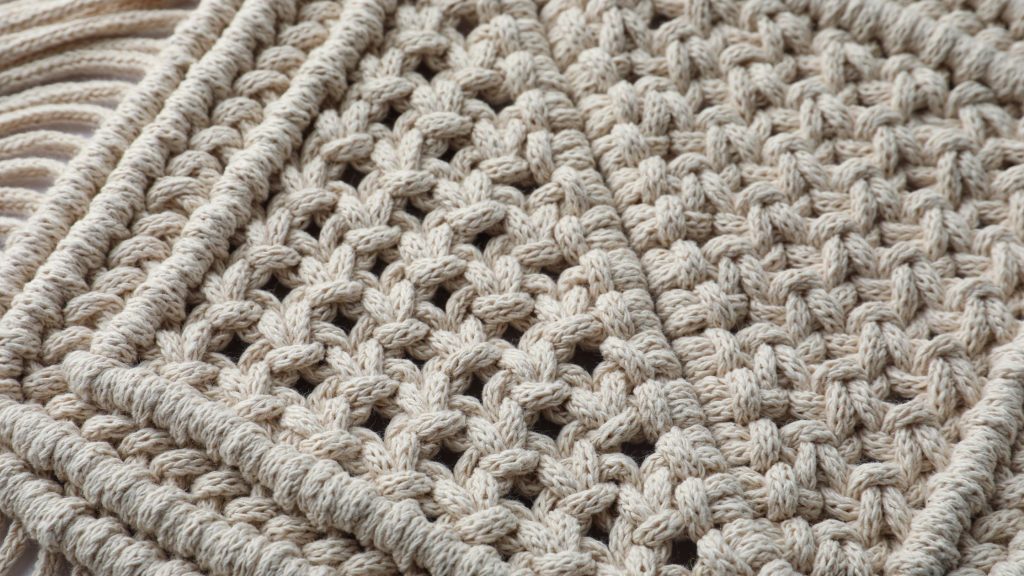Macrame, the ancient art of knotting cords to create intricate patterns, has a rich and fascinating history that spans centuries. From its origins in ancient Egypt and the Arab world to its popularity during the Victorian era and resurgence in the 1970s, macrame has seen a remarkable evolution. This article explores the timeline of macrame’s history, tracing its roots and highlighting key milestones along the way. So, if you’ve ever wondered about the origins and development of this beautiful craft, you’re in for a treat. Let’s unravel the threads of macrame’s past and embark on a journey through time.
Ancient Origins
Macrame, the art of knotting cords or threads to create decorative and functional items, has a rich and diverse history that spans across cultures and centuries. Its origins can be traced back to ancient civilizations such as Ancient Egypt, where evidence of macrame can be found in wall hangings, textiles, and even mummy wrappings. The intricate knotting techniques used in macrame were not only aesthetically pleasing, but they also served practical purposes such as securing items and creating strong, durable structures.
Origins in Ancient Egypt
In Ancient Egypt, macrame was widely practiced and used for various purposes. The Egyptians adorned their homes with macrame wall hangings and used intricate knotting techniques to create textiles and clothing. Macrame was also used to decorate tombs and burial sites, as well as to create intricate jewelry and accessories.
Spread to the Middle East
From Ancient Egypt, macrame spread to the Middle East, where it gained popularity and further developed. Arab traders and merchants played a crucial role in spreading the art form to different regions, including Persia, Turkey, and Morocco. Macrame continued to flourish in these regions, with each culture putting its unique spin on the craft and incorporating local motifs and designs.
Influence in Ancient China
Macrame also made its way to Ancient China, where it became an integral part of their artistic traditions. The Chinese embraced macrame and incorporated it into their textile production, using it to create intricate weavings and knotting patterns in clothing, tapestries, and accessories. Macrame in Ancient China was known for its symbolic meanings, with different knots representing different blessings and wishes.
Medieval Europe and Renaissance
As trade routes expanded and cultural exchange flourished, macrame found its way to Medieval Europe, where it continued to evolve and thrive. During this time, macrame became a significant decorative element in European fashion and decor.
Introduction to Europe
Macrame gained popularity in Europe during the 13th century, primarily as a result of the Crusades and increased trade with the Middle East. European artisans were fascinated by the intricate knotting techniques used in macrame and began incorporating the craft into their own designs.
Use in Fashion and Decor
During the Renaissance, macrame became a prominent feature in both fashion and home decor. Wealthy merchants and nobles adorned their clothing and accessories with macrame, showcasing their social status and wealth. Macrame also became a popular decorative element in castles and palaces, with elaborate macrame tapestries and curtains adorning grand halls and chambers.
Popularity during the Renaissance
The Renaissance period saw a surge in macrame’s popularity, with the craft being highly valued and respected. Macrame techniques were taught in specialized schools, and skilled artisans were highly sought after. The intricate knotting patterns and designs became more complex and elaborate, making macrame a true art form.
Influence in the Americas
Macrame found its way to the Americas through the explorations and colonization efforts of European nations. The craft had a significant impact on Native American culture, and later, on the colonial and Victorian era.
Introduction to the Americas
Macrame was introduced to the Americas by European explorers and colonizers, who brought their knowledge of the craft with them. Macrame quickly became intertwined with Native American culture, and the Native American tribes incorporated macrame into their traditional practices and ceremonies.
Macrame in Native American Culture
For Native American tribes, macrame held great significance and was used to create intricate and meaningful textiles and accessories. Macrame patterns and designs were passed down from generation to generation, with each tribe adding its unique elements and symbols. Macrame was not just a decorative craft for Native Americans; it was a way to connect with their ancestors and preserve their cultural heritage.
Colonial and Victorian Era
During the colonial and Victorian eras, macrame continued to be embraced in the Americas. The craft was used to create decorative items for homes, such as curtains, plant hangers, and table runners. Macrame was particularly popular in Victorian households, with intricate lace-like designs adorning furniture and accessories.
20th Century Revival
Macrame experienced a revival in the 20th century, fueled by various movements and trends. From the arts and crafts movement to the booming popularity of the 1970s, macrame became a symbol of creativity and self-expression.
Macrame in the Arts and Crafts Movement
The arts and crafts movement of the late 19th and early 20th centuries emphasized the value of handmade goods and the connection between art and everyday life. Macrame, with its intricate knotting techniques and versatile applications, is perfectly aligned with the principles of the arts and crafts movement. Artisans and crafters embraced macrame, incorporating it into their work and creating unique and beautiful pieces for both functional and decorative purposes.
Macrame’s Popularity in the 1970s
The 1970s witnessed a macrame craze, with the craft reaching its peak popularity. Macrame was embraced by the hippie and bohemian subcultures, who saw it as a way to create unique and personalized items. From wall hangings and plant hangers to clothing and accessories, macrame was everywhere. The craft symbolized the counterculture movement, representing a connection to nature, self-sufficiency, and individuality.
Modern Macrame Trends
In recent years, macrame has experienced a resurgence in popularity, with modern crafters and designers putting their own twist on the ancient art form. Macrame is now seen in contemporary interior design, fashion, and art. From minimalist wall hangings to intricate jewelry, macrame continues to captivate and inspire.
Macrame Techniques
Macrame is a versatile craft with a wide range of knotting techniques. Understanding the basic knots and exploring variations can help you create unique macrame pieces.
Basic Knots
The foundation of macrame lies in a few basic knots. The square knot is one of the most commonly used knots in macrame, created by crossing two cords and looping them to create a square shape. The half knot is made by tying a simple knot with two cords, either vertically or horizontally. By combining these basic knots, you can create a variety of patterns and designs.
Variations in Knotting Techniques
Beyond the basic knots, macrame offers a plethora of knotting techniques that can be combined to create intricate designs. Double half hitch knots are used to create diagonal or angled patterns, while spiral knotting creates a twisted effect. Josephine knots create elegant loops, and larks head knots are often used for attaching cords to a base. Exploring these different techniques allows for endless creativity and customization in macrame projects.
Advanced Techniques and Innovations
As macrame has evolved over the centuries, artisans have developed advanced techniques and innovations to push the boundaries of the craft. Micro-macrame involves working with excellent cords and creating intricate, detailed patterns. Surface and structural techniques add texture and dimension to macrame pieces, while contemporary innovations such as incorporating beads and crystals add a modern twist to the art form. The possibilities for experimentation and innovation in macrame are endless.
Macrame in Contemporary Design
Macrame has found a new home in contemporary design, with its unique textures and handmade appeal adding warmth and character to various areas of design.
Macrame in Interior Design
In interior design, macrame has become a popular choice for adding depth and visual interest to living spaces. Macrame wall hangings, plant hangers, and curtains can bring a touch of bohemian charm or modern minimalism to any room. Macrame can also be used in lighting fixtures, creating a beautiful interplay of light and shadows. From small accents to statement pieces, macrame has become a staple in contemporary interior design.
Fashion and Accessories
Macrame has made a stylish comeback in the world of fashion and accessories. From macrame jewelry incorporating semi-precious stones to macrame handbags and belts, the possibilities for incorporating macrame into your personal style are endless. Macrame adds a unique and handmade touch to any outfit, making a fashion statement while staying true to sustainable and ethically made products.
Macrame in Art and Sculpture
Artists and sculptors have embraced macrame as a medium for expressing their creativity and bringing their visions to life. Macrame sculptures, installations, and fiber art have gained recognition in the art world, with artists pushing the boundaries of the craft and experimenting with new techniques and materials. Macrame has become a unique and captivating form of artistic expression.
Macrame in Pop Culture
Macrame has left its mark on various aspects of pop culture, influencing music, film, literature, and television shows.
Macrame in Music and Film
From album covers to music videos, macrame has made appearances in the music industry. The aesthetics of macrame have been embraced by musicians and bands, often creating a connection to nature and the earth. In film, macrame has been featured as set decorations, adding a bohemian or vintage vibe to scenes. Macrame jewelry and clothing have also been worn by actors, further enhancing the visual appeal of characters.
Macrame in Literature and Poetry
Macrame has inspired writers and poets, with its intricate knots and symbolism serving as metaphors for connection, strength, and creativity. Macrame can be found in descriptions of settings and as a literary device in storytelling. Its presence in literature adds a layer of depth and texture to the narrative.
Macrame in Television Shows
Television shows have also tapped into the popularity of macrame, featuring characters who engage in macrame or adding macrame decor to set designs. From sitcoms to dramas, macrame has become a visual element that enhances the ambiance and character development within the show.
Macrame as a Therapeutic Activity
Beyond its aesthetic appeal, macrame offers numerous therapeutic benefits, making it a popular activity for relaxation and mindfulness.
The Calming Benefits of Macrame
Engaging in macrame can have a calming and soothing effect on the mind and body. The repetitive motion of knotting can be meditative, helping to reduce stress and anxiety. Focusing on the knots and patterns allows you to be fully present in the moment, promoting mindfulness and relaxation.
Macrame as a Mindfulness Practice
Macrame offers an opportunity to practice mindfulness, as it requires your full attention and concentration. As you engage in the craft, you become attuned to the texture of the cords, the feel of the knots, and the progress of your creation. Macrame can be a mindful practice that allows you to connect with your creativity and find inner peace.
Macrame in Art Therapy
Macrame has also been embraced as art therapy, allowing individuals to express themselves creatively while promoting emotional healing and self-discovery. Creating something with your hands can provide a sense of accomplishment and empowerment, and macrame can serve as a therapeutic outlet for processing emotions and finding solace.
Macrame’s Global Resurgence
Macrame’s revival in the 20th century has continued to gain momentum, with the craft now being celebrated and practiced globally.
Macrame’s Influence on DIY Culture
The rise of the do-it-yourself (DIY) culture has been instrumental in macrame’s resurgence. The accessibility of online tutorials, patterns, and supplies has made it easier for individuals to learn and practice macrame. DIY enthusiasts have embraced macrame as a versatile and rewarding craft, incorporating it into their home decor, fashion, and gift-making.
Online Macrame Communities
Online communities and social media platforms have provided a space for macrame enthusiasts to connect, share ideas, and support one another. From dedicated macrame groups on Facebook to hashtags on Instagram, these communities have fostered a sense of camaraderie and encouraged the exploration of new techniques and designs. They have also served as platforms for sharing knowledge, organizing workshops, and showcasing macrame creations.
International Macrame Festivals
Macrame festivals and gatherings have become popular events, attracting artists, crafters, and enthusiasts from around the world. These festivals celebrate the artistry and creativity of macrame, showcasing a diverse range of styles and techniques. They offer workshops, exhibitions, and networking opportunities, allowing individuals to deepen their knowledge of macrame and connect with like-minded individuals.
Exploring New Frontiers in Macrame
As macrame continues to captivate artists and crafters, new frontiers are being explored and boundaries pushed.
Experimental Macrame Techniques
Artisans and macrame enthusiasts are constantly pushing the boundaries of traditional macrame, exploring new techniques, and experimenting with unconventional materials. From combining macrame with other fiber arts to incorporating unconventional objects and textures, experimental macrame techniques are pushing the craft into exciting new territory.
Incorporating New Materials
Traditionally, macrame was made using natural fibers such as cotton, linen, and jute. However, contemporary macrame artists are exploring the use of unconventional materials such as ropes, wires, leather, and even recycled materials. This allows for exciting opportunities for texture, color, and mixed-media collaborations.
Macrame in Installation Art
Macrame is expanding into the world of installation art, where artists create large-scale, immersive pieces that transform spaces. Macrame installations can be found in galleries, public spaces, and even outdoor environments. These art pieces captivate viewers and create a sense of awe and wonder, showcasing the versatility and beauty of macrame on a grand scale.
Conclusion
In conclusion, macrame has a long and fascinating history that spans cultures, centuries, and continents. From its ancient origins in Egypt to its influence in Europe, the Americas, and beyond, macrame has evolved and adapted to reflect the unique traditions and artistic expressions of each culture. Today, macrame continues to capture the hearts and minds of artists, crafters, and enthusiasts around the globe, proving that this ancient craft still has countless stories to share and endless possibilities to explore. So why not grab some cords, learn a few knots, and embark on your own macrame journey? The world of macrame awaits you with open arms and a friendly community of fellow knot enthusiasts. Happy knotting!

